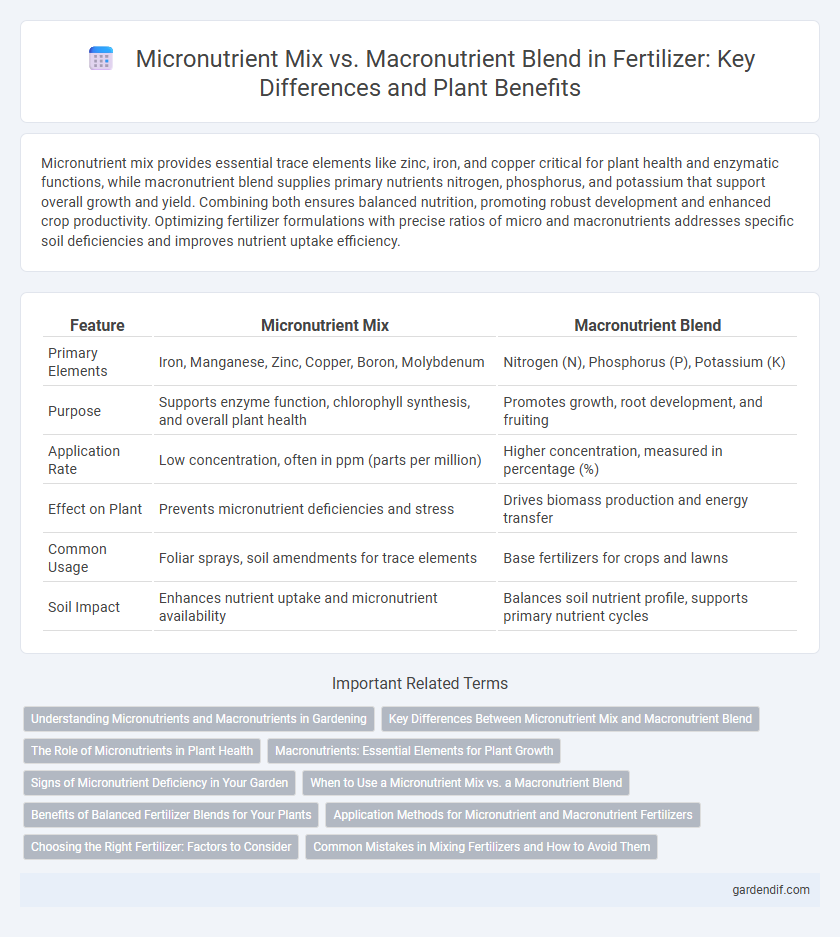
Micronutrient mix vs Macronutrient blend Illustration
Micronutrient mix provides essential trace elements like zinc, iron, and copper critical for plant health and enzymatic functions, while macronutrient blend supplies primary nutrients nitrogen, phosphorus, and potassium that support overall growth and yield. Combining both ensures balanced nutrition, promoting robust development and enhanced crop productivity. Optimizing fertilizer formulations with precise ratios of micro and macronutrients addresses specific soil deficiencies and improves nutrient uptake efficiency.
Table of Comparison
| Feature | Micronutrient Mix | Macronutrient Blend |
|---|---|---|
| Primary Elements | Iron, Manganese, Zinc, Copper, Boron, Molybdenum | Nitrogen (N), Phosphorus (P), Potassium (K) |
| Purpose | Supports enzyme function, chlorophyll synthesis, and overall plant health | Promotes growth, root development, and fruiting |
| Application Rate | Low concentration, often in ppm (parts per million) | Higher concentration, measured in percentage (%) |
| Effect on Plant | Prevents micronutrient deficiencies and stress | Drives biomass production and energy transfer |
| Common Usage | Foliar sprays, soil amendments for trace elements | Base fertilizers for crops and lawns |
| Soil Impact | Enhances nutrient uptake and micronutrient availability | Balances soil nutrient profile, supports primary nutrient cycles |
Understanding Micronutrients and Macronutrients in Gardening
Micronutrients such as iron, manganese, and zinc play essential roles in plant enzyme functions and chlorophyll production, albeit required in smaller quantities compared to macronutrients like nitrogen, phosphorus, and potassium, which drive growth and energy transfer. Balanced fertilization that combines a tailored micronutrient mix with a robust macronutrient blend ensures optimal soil health and maximizes plant development, yield, and resistance to diseases. Precision in nutrient management through soil testing enables gardeners to apply the correct ratios, preventing deficiencies or toxicities that compromise plant vigor.
Key Differences Between Micronutrient Mix and Macronutrient Blend
Micronutrient mix contains essential trace elements like iron, zinc, copper, manganese, and boron that support enzymatic functions and overall plant health, whereas macronutrient blend primarily consists of nitrogen, phosphorus, and potassium, which are required in larger quantities for core growth and development. Micronutrients are crucial for metabolic processes and nutrient uptake efficiency, while macronutrients provide the fundamental building blocks for cell structure and energy transfer. The precise balance of both micronutrient mixes and macronutrient blends ensures optimal crop yield and prevents nutrient deficiencies in various soil types.
The Role of Micronutrients in Plant Health
Micronutrient mixes provide essential elements like iron, manganese, zinc, copper, molybdenum, boron, and chlorine, which are crucial for enzyme function, photosynthesis, and overall plant metabolism, ensuring optimal growth and stress resistance. Macronutrient blends primarily supply nitrogen, phosphorus, and potassium, which support major structural and energy processes but cannot substitute for micronutrient deficiencies. Balanced fertilization with appropriate micronutrient supplementation enhances nutrient uptake efficiency, improves crop yield quality, and mitigates common physiological disorders related to nutrient imbalances.
Macronutrients: Essential Elements for Plant Growth
Macronutrients such as nitrogen, phosphorus, and potassium constitute the primary elements required for robust plant growth, supporting essential processes like photosynthesis, energy transfer, and root development. A balanced macronutrient blend ensures optimal nutrient availability, improving crop yield and overall plant health. While micronutrients are vital in trace amounts, macronutrients form the foundational building blocks for plant metabolic functions and structural integrity.
Signs of Micronutrient Deficiency in Your Garden
Micronutrient deficiency in gardens often manifests as interveinal chlorosis, stunted growth, and leaf deformities, indicating a lack of essential elements like iron, zinc, or manganese. These symptoms differ from macronutrient deficiencies, which typically cause overall yellowing or poor plant vigor due to insufficient nitrogen, phosphorus, or potassium. Early detection and targeted application of a micronutrient mix can restore plant health and optimize crop yield.
When to Use a Micronutrient Mix vs. a Macronutrient Blend
Micronutrient mixes are essential when specific trace elements like zinc, iron, or manganese are deficient, supporting critical plant functions such as enzyme activation and chlorophyll production. Macronutrient blends, rich in nitrogen, phosphorus, and potassium, are necessary during peak growth stages to promote overall plant development and yield. Use micronutrient mixes to correct deficiencies or prevent stress, while macronutrient blends provide the foundational nutrients for sustained growth.
Benefits of Balanced Fertilizer Blends for Your Plants
Balanced fertilizer blends combining micronutrient mix and macronutrient blend optimize plant growth by delivering essential nutrients like nitrogen, phosphorus, potassium, zinc, and iron in precise proportions. These formulations enhance nutrient uptake efficiency, improve soil health, and prevent deficiencies that could stunt development or reduce yield. Consistent use of balanced fertilizers supports robust root systems, increases resistance to pests, and maximizes overall crop productivity.
Application Methods for Micronutrient and Macronutrient Fertilizers
Micronutrient fertilizers are typically applied as foliar sprays or soil drenches to target specific nutrient deficiencies, ensuring rapid absorption and precise nutrient delivery. Macronutrient fertilizers are commonly incorporated into the soil through broadcasting, banding, or fertigation to support overall crop growth with essential elements like nitrogen, phosphorus, and potassium. Selecting the appropriate application method enhances nutrient use efficiency and minimizes environmental impact.
Choosing the Right Fertilizer: Factors to Consider
Selecting the right fertilizer involves balancing micronutrient mixes, which provide essential trace elements like iron, zinc, and manganese, with macronutrient blends rich in nitrogen, phosphorus, and potassium, critical for plant growth and yield. Soil composition, crop type, and growth stage determine nutrient requirements, guiding the choice between targeted micronutrient supplements and comprehensive macronutrient formulas. Testing soil nutrient levels ensures optimal fertilizer application, preventing nutrient deficiencies or toxicities while promoting sustainable agricultural productivity.
Common Mistakes in Mixing Fertilizers and How to Avoid Them
Common mistakes in mixing fertilizers include incorrect proportions of micronutrient mix and macronutrient blend, leading to nutrient imbalances and reduced crop yield. Over-application of macronutrients like nitrogen, phosphorus, and potassium can overshadow essential micronutrients such as zinc, iron, and manganese, causing deficiencies despite adequate total fertilization. Ensuring precise measurement, uniform distribution, and compatibility testing prevents nutrient antagonism and promotes optimal plant growth.
Micronutrient mix vs Macronutrient blend Infographic

 gardendif.com
gardendif.com